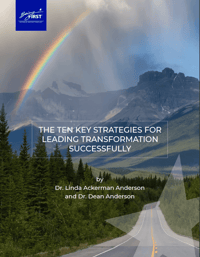Sponsoring transformational change requires you, as CEO, to understand what makes people tick, both what ignites their passion and commitment and what causes them to resist change. It is also imperative to be strategic about the changes required in your organization’s culture—a key factor that will make your change sustain long term.
Why Change Initiatives Fail
Most change initiatives fail because they are not adopted by the people directly effected in the organization, not because your “content” solution was wrong.
When change fails, it is often because people’s resistance was triggered by the change process, political maneuvering derailed the effort, employees became suspicious or afraid to change, or once deployed, people simply ignored the new state and found “work-arounds” to continue using the old technology or process. Sound familiar? This can all be averted by proactively addressing the people and cultural dynamics.
Addressing Human and Cultural Issues
Your strategy for making your most important changes must include attention to the human and cultural issues triggered by the change. Are you equipped? Can you see down the road how people might react and what they need from you to know they will be successful? Having a sound grasp of the human dynamics during change, including employee motivation, causes of resistance, the impact of communication and behavioral styles, and emotional reactions and how to constructively deal with them, is essential. Having line of sight into the impacts your change may have on your existing culture, and understanding how to transform your cultural norms to serve your outcomes are key strategies for ensuring that your future state will not only happen, but have longevity.
Most CEOs are far more comfortable dealing with the content solutions of their changes than with the people requirements. They understand their markets, customers, products and services, business models, and organizational systems and processes, but are not comfortable with how to constructively address the psychology of people, change, or culture. Many CEOs have not given adequate attention to the people dynamics triggered by their changes, preferring to delegate this to others and assume that they will handle the people issues when they arise. The key to setting up your change for success and speed is to deal with these issues in your initial change strategy, rather than wait until they are already brewing or exploding!
Not attending to human dynamics will have you inadvertently make decisions that have negative impacts on your people and won’t allow you to surface ways to prevent or mitigate those impacts.
Here are a few examples of emotionally-costly decisions:
- Cut twenty percent from budgets without cutting anyone’s scope of work.
- In a reorganization, take everyone’s job away and require them all to vie for new positions.
- Fail to ask key people impacted by the change for input to the design of the new organization or business solution they will be evaluated on.
- Fail to provide a relevant and meaningful business case for the change. Expect people to follow your executive mandate without airing their questions or fears about the change.
- Say “yes” to certain aspects of your change plan without really understanding what your “yes” means, then change your decision mid-stream once you do understand the impacts, jerking your people around.
These common actions will disrupt your change effort, slow it down, and make it far more costly.
Transformational Change
People issues have not always been of such great concern. Until the 1990’s, the majority of organizational change was developmental or transitional, with far less significant human impact. At most, people had to modify certain behaviors or learn new but similar skills to adopt a change. But now, most major change is transformational, which impacts people far more significantly, often emotionally, threatening their belief and value systems. When transforming organizational culture, fundamental ways of thinking, being, relating to others, and operating are often radically changed. This makes expert treatment of human and cultural issues a critical success factor in transformation.
What Is Required as CEO
As CEO, learn the strategies for effectively handling human and cultural dynamics so you and your leaders can make intelligent decisions about how to proactively handle them from the very beginning of your transformation. Doing so will make you and your leaders better able to design and implement your change initiatives to ensure greater buy-in, faster employee engagement, minimize resistance, and support people to commit and participate in positive ways. This is a core accelerator of change and a sure way to minimize cost! And, by the way, it will radically increase your leadership credibility.
Related eBook:
The Ten Key Strategies for Leading Transformation

Through 40 years of observing and supporting large-scale change and transformation in Fortune 500, government, global NGOs and public service organizations, we’ve identified these ten Best Practice strategies for leading transformation successfully.
Please complete the form to download your eBook:
Related Webinar:
Why Culture Change Success is Directly Linked to CEO Behavior
Dr. Dean Anderson explores the most effective culture change strategy and leadership style that creates a safe environment and inspires managers and employees to change. This approach inspires your leaders and stakeholders to change company culture in positive ways to achieve your organization's vision.

